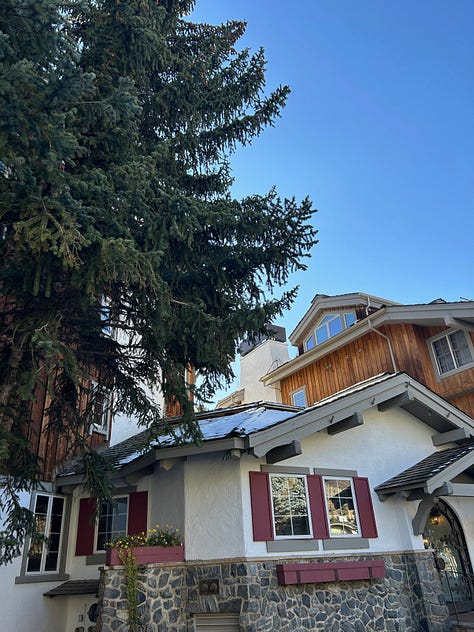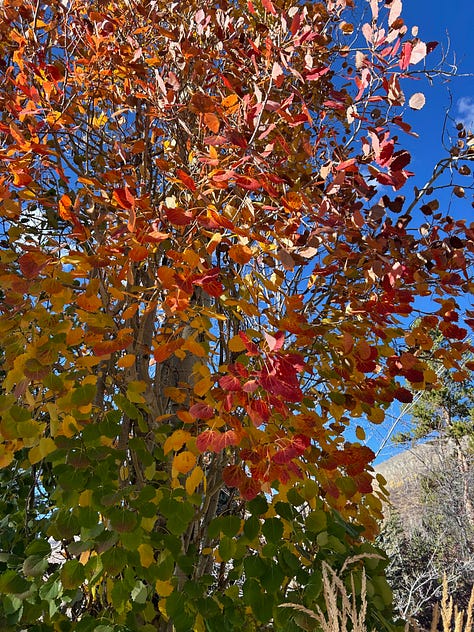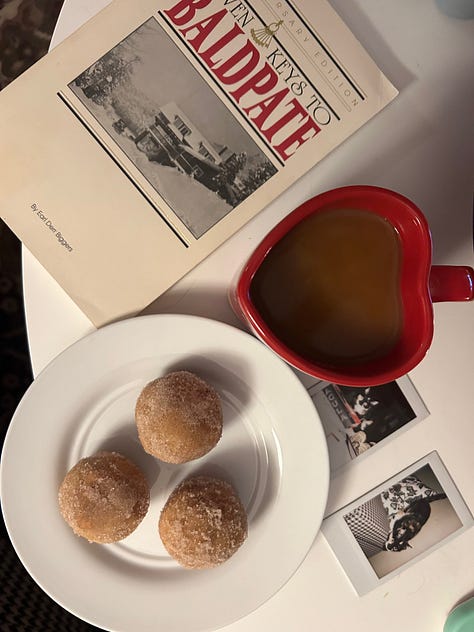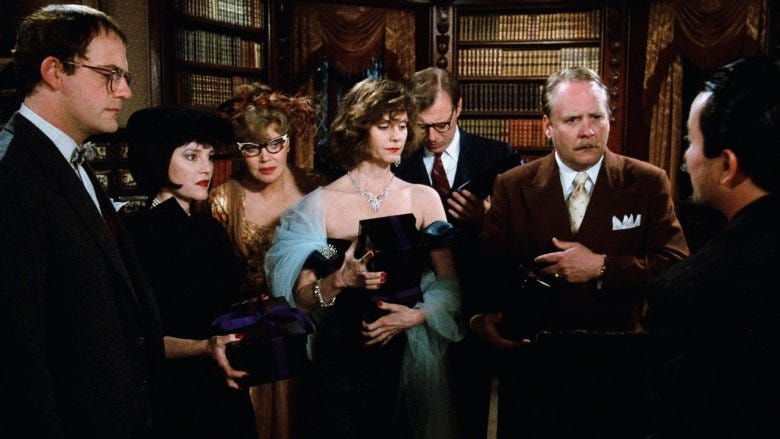a letter to the beginning of november
October is one of my favourite months, and it always seems to go by too fast. I spent Halloween night in class, the sound of fireworks disrupting our lectures and discussions all night long. As it got dark, flashes of colour appeared just beyond the thick panes of the window, beautiful and unsettling. On my walk home, I could feel the cold of November already nipping at my heels in the dark. I was away when the clocks changed this year. When I returned to Dublin this week, the lengthening nights of late autumn were already encroaching on my days. Winter is on the horizon, here, spectral and threatening.
But before the autumn season comes to a close, I’ve been relishing in scary stories and spooky mysteries and bad horror movies and all of the fun atmosphere and entertainment of Halloween. I’ve been thinking and reading and talking a lot lately about one of the most fun microgenres that I think perfectly accompanies the transition from the spooky season of October to the coming winter chill: the locked-in murder mystery.
the mysterious mansion mystery
I don’t know what this type of story is actually called, or if it has a specific name, but I love it. The essential example, I think, of what I’m talking about is the Agatha Christie novel And Then There Were None.
Ten apparent strangers find themselves guests on an isolated island, brought together by a mysterious host. One by one, secrets are revealed and guests begin to disappear, leading readers towards the ominous conclusion suggested by the title as the narrative counts down. With no means of escape from the house and the island, each character must face their doomed fate.
This type of story is exemplified too, in a more playful way, by the 1985 cult classic film Clue. Inspired by the board game of the same name1, which draws on the tropes and stock characters of murder mysteries for its concept, Clue parodies the idea of the locked in mystery, once again following a group of strangers all invited to attend a party at a mysterious mansion, where they soon find themselves locked in and must face murders, blackmail plots, secret passages, and lots of silliness. When it premiered in theatres, the film had three possible endings, a nod to the near infinite possible endings of the board game, but also a clever spin on the classical big reveal we expect to see at the end of such a mystery story. This film is particularly interesting because it both played with the already well known idea of this type of mystery story, but also became an emblematic version of the story in itself that is often imitated and referenced in popular culture.
I love that mystery as a genre is so self-aware and self-absorbed in this way. When we read the earliest Sherlock Holmes stories, we find Arthur Conan Doyle poking fun at Edgar Allen Poe and the detective stories of the time. In many of Agatha Christie’s novels, her detective characters talk about Sherlock Holmes and contemporary crime fiction. Murder by Death is another murder mystery comedy film that feels very Clue-adjacent, and follows a group of successful detectives who are all(surprise surprise) invited to a mysterious mansion and asked to compete for a prize, and (surprise surprise surprise) murder is quick to follow. Each character is modelled after a well known character from golden age detective fiction, and the mysterious occurrences and dastardly traps they find in the mansion tease out the melodramatic tropes of the country house mystery.
Many great mystery stories are just stories about mystery stories. Another novel that fits into this pattern that absolutely fascinates me is The Decagon House Murders by Yukito Ayatsuji, a 1987 novel that directly references And Then There Were None and other works of the genre. A group of students, members of a university mystery club, travel to stay in a house on a remote island with a dark past, and much like the original story it is mapped onto, the guests are murdered one by one. This mystery story is built up of a lot of clever puzzle pieces, from the actual clues of the novel—the unsettling history of the island and its past residents, diagrams of the peculiarly built, ten sided house where the students find themselves trapped, mysterious notes, etc.— to the atmospheric, mystery-obsessed set dressing that makes it especially memorable, like the way that each member of the club takes on the name of a mystery novelist(one student is called Agatha), and all the other nods to the mystery genre imagery that inspired the novel.
I think the obsession with genre itself that we see in this genre is part of what makes it so enjoyable. They encourage the reader(or viewer) to not just hear the story, but to take part and play the game. The formulaic nature of the stories means that there are clear rules to follow, and that just like when playing a game of Clue(do), we can try to piece things together and find the solution: the murderer was x with y in the z. And by following these rules, these stories can immerse us in a specific world and atmosphere with ease, knowing that we’ll recognise the types of characters and the types of storytelling techniques we’re presented with, letting us get straight into the fun of mystery and puzzle solving.
Maybe the best version of this whole Trapped in a Mansion Mystery story is the Trapped in the Snow Mystery. This is essentially the same story, but in these ones, the characters are snowed in! There are plenty of examples of this type of story. We can go back to Agatha Christie and think about her play The Mousetrap, where a mystery unfolds among house guests trapped inside during a snow storm. For a very niche version, I turn to my personal cult classic, the 2001 Neopets.com plot “Ski Lodge Murder Mystery” where fictionalised versions of the real life Neopets staff go on a group trip to a remote ski lodge, which quickly takes a turn when they are murdered one by one in increasingly bizarre and comedy-mysterious ways.2 In The Shining, characters are trapped by winter weather in an isolated mountain top hotel of ghosts and murders.3 And in the mystery novel I am currently reading, 1913’s Seven Keys to Baldpate, a group of individuals, each with mysterious purposes, is drawn in the dead of winter to a mountain resort that is closed for the season; the group finds themselves snowed in together(although, so far, no murders?) as they each try to enact their own schemes and uncover the mysterious secret hidden at the remote inn.
I mention these because I think they really speak to the other thing that I love about this type of locked in mystery story: the atmosphere created by the juxtaposition of the cozy with the claustrophobic. These stories work best when they run on a closed circuit — everyone must remain in the space of the mystery, where curious and horrible things occur freely within the suspended, extraordinary space of the murderous mansion or remote house. There are generally a set number of characters, each of whom is a suspect until ruled out by becoming a victim. The high stakes and close parameters become at times claustrophobic. Yet as much as the characters are trapped, there is also something wonderful about being in that world where one has nowhere to go, where there are sitting rooms and fireplaces and the rituals of dinners, pantries of canned food, keys in doors and candles alit and creaky stairs to ascend. Within this isolated world of mystery, the familiar coziness of an inn in a snowstorm is transformed into such a unique, electric atmosphere, where we as the audience get drawn in and trapped too, locked in to the mystery until the puzzle is solved and we return.



Just before Halloween, I watched The House on Haunted Hill, a campy and delightful 1959 horror film that stars fun-horror icon Vincent Price as an eccentric millionaire who invites a group of strangers to stay in a haunted house, offering a prize of $10,000 dollars to anyone who can make it through one night in the mansion(even if you haven’t seen the film, you may be familiar with a clip of him saying the word “amusing” and describing a party of “food and drink and ghosts… and perhaps a few murders”). The film is funny, formulaic, bizarre, and made me think about how much I love this kind of cliche(or classic—I’ll let you decide) mystery story, both at its most serious and its most silly. It feels like a fun genre to continue to read and watch at this time of year, and as much as I am dreading the oncoming winter and missing the fun of October, I’m already looking forward to a cold(and snowy, if I’m lucky) winter day when I can find a nice country house/remote island mansion/snowy inn type of novel and get locked in to the mystery :-)
Thank you for reading this week’s lil newsletter! If you are new to cloudtopia, please consider subscribing for weekly(ish) updates on upcoming topics including more mystery novels, art museum discussions, and other reflections on art & culture.
until next time!
isobel
I don’t want to get into the whole clue/cluedo thing
When I first read this comic as a child it was probably my first introduction to this type of story! It also scared me soooooo much
Do you think this counts? I was really back and forth about even mentioning it :S




